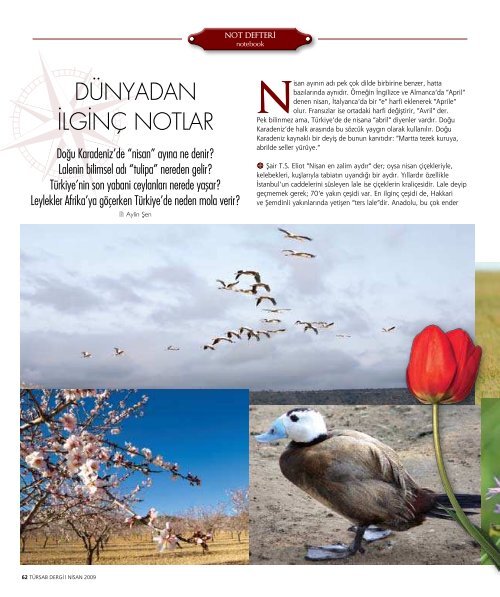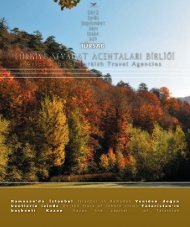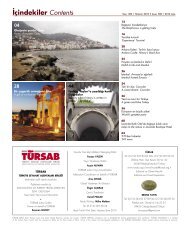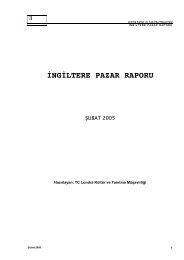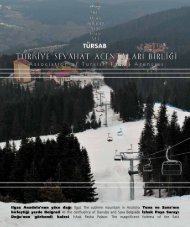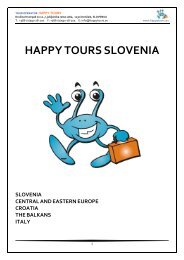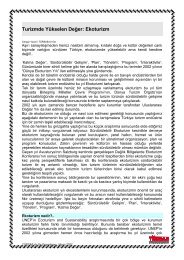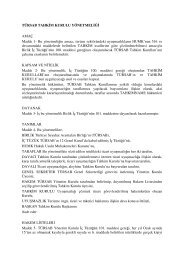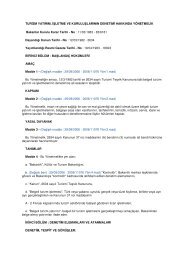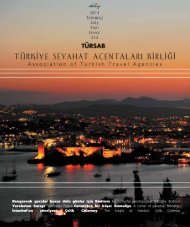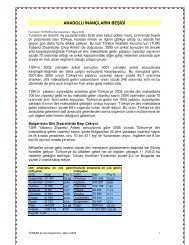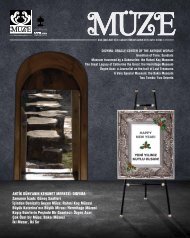Nisan 2009 - Türkiye Seyahat Acentaları Birliği
Nisan 2009 - Türkiye Seyahat Acentaları Birliği
Nisan 2009 - Türkiye Seyahat Acentaları Birliği
- No tags were found...
You also want an ePaper? Increase the reach of your titles
YUMPU automatically turns print PDFs into web optimized ePapers that Google loves.
DÜNYADANİLGİNÇ NOTLARDoğu Karadeniz’de “nisan” ayına ne denir?Lalenin bilimsel adı “tulipa” nereden gelir?<strong>Türkiye</strong>’nin son yabani ceylanları nerede yaşar?Leylekler Afrika’ya göçerken <strong>Türkiye</strong>’de neden mola verir?2 Aylin ŞenNOT DEFTERİnotebook<strong>Nisan</strong> ayının adı pek çok dilde birbirine benzer, hattabazılarında aynıdır. Örneğin İngilizce ve Almanca’da “April”denen nisan, İtalyanca’da bir “e” harfi eklenerek “Aprile”olur. Fransızlar ise ortadaki harfi değiştirir, “Avril” der.Pek bilinmez ama, <strong>Türkiye</strong>’de de nisana “abril” diyenler vardır. DoğuKaradeniz’de halk arasında bu sözcük yaygın olarak kullanılır. DoğuKaradeniz kaynaklı bir deyiş de bunun kanıtıdır: “Martta tezek kuruya,abrilde seller yürüye.”Şair T.S. Eliot “<strong>Nisan</strong> en zalim aydır” der; oysa nisan çiçekleriyle,kelebekleri, kuşlarıyla tabiatın uyandığı bir aydır. Yıllardır özellikleİstanbul’un caddelerini süsleyen lale ise çiçeklerin kraliçesidir. Lale deyipgeçmemek gerek; 70’e yakın çeşidi var. En ilginç çeşidi de, Hakkarive Şemdinli yakınlarında yetişen “ters lale”dir. Anadolu, bu çok enderCURIOUS NOTES ACROSS THE WORLDWhat’s the name of “April” in East Black Sea Region?Where does “tulipa”, the scientific name of “tulip”, come from?Where do the last remaining wild gazelles live in Turkey?Why do the storks have a break in Turkey on their migration wayto Africa?The names used for April are similar to each other in many languagesand they are even the same in some. For example, it’s “April” in Englishand German and turns to “Aprile” in Italian with the addition of “e”.French change the letter in the middle and say “Avril”. It may not bewidely known but there are people using the word “april” in Turkey.This word is widely used among people in East Black Sea region. Anexpression originating from the East Black Sea proves it: “Martta tezekkuruya, abrilde seller yürüye.” (Cow dung dries in March and floodsinundate in abril.”“April is the most barbarian month” says the poet T.S. Eliot;however, the nature wakes up in April with flowers, butterflies andbirds. The tulip which decorates the streets of Istanbul since years isthe queen of the flowers. The tulip should not be underestimated; it hasaround 70 sorts. And the most interesting sort is “reverse tulip” growngörülen çeşidiyle birlikte lale cennetisayılır; ama çok ilginç bir katkısı dahavardır lalelerinin. Avrupa bu benzersizçiçekle 16. yüzyılda tanıştı. KanuniSultan Süleyman tarafından HollandaKralı’na gönderilen “tülbent lalesi” kısazamanda Avrupa’da çılgın bir modayadönüştü. Bu isim zaman içinde değiştive “tülbent” adı “tulipa”ya dönereklalenin “bilimsel adı” oldu.<strong>Türkiye</strong> kuş çeşidi bakımından datam bir cennet. Sessiz sedasız bir turizmalanına, kuş gözlemciliğine de evsahipliği yapıyor. Sıradaki not, onlarıheyecanlandıracak bir haber veriyor:Burdur Gölü’nde yapılan son “sukuşusayımı”, küresel ısınma yüzündenbozulan moralleri düzeltti; çünküsayıma göre, “dikkuyruk” sayısı geçenyıl 655 iken iki katına çıkmış, 1223’eulaşmıştı.Kuşlar Türk geleneklerinde önemlibir yere sahiptir; ama içlerindensadece biri özel bir unvanla anılır:Leyleklerden, kuzeyden gelip güneye,Arap çöllerine doğru göç ettiği için“hacı” diye söz edilir. Bilim dünyasıiçinse Anadolu’nun leylekler açısındanapayrı bir yeri vardır; çünkü Anadolu,leyleklerin iki ana göç yolundanbiri üzerindedir. Ayrıca, leyleklerAnadolu’dan hemen geçip gitmez.Bu topraklarda yavrular ve o yavrularınilk uçuş eğitimini yine burada verir.Ünlü Fransız yazar Jean ChristopheGrange, Leyleklerin Uçuşu adlı gerilimromanında bu ilginç özelliktenyararlanmış, bir sırrın izini leyleklerlesürmeye çalışırken çok ilginç bilgilervermişti.<strong>Türkiye</strong>, küresel ısınma yüzündentehdit altında bulunsa da, benzersizbir “flora ve fauna”, yani bitki vehayvan varlığına sahip; örneğinbu topraklardaki 451 canlı türüyeryüzünün başka hiçbir noktasındayaşamıyor. Ancak bu zenginliğikorumak da her geçen gün zorlaşıyor.Yabani ceylan buna çarpıcı bir örnek.Güneydoğu masallarının, efsanelerininvazgeçilmezi ceylanlardan “yabani”olarak sadece 80 adet kaldığı tespitedildi. Bu son ceylanların yaşam alanıise, çok sayıda efsaneye de ev sahipliğiyapan Şanlıurfa’nın bozkırları.near Hakkari and Şemdinli. The Anatoliais seen as a heaven of tulips together withthis rarely found type; on the other hand,the tulips have another curious story.Europe got acquainted with this flower inthe 16th century. “tülbent lalesi” (muslintulip) sent by Kanuni Sultan Suleiman tothe King of Netherlands became soon afashion in Europe. This name changed in ashort time and the name “tülbent” changedto “tulipa” and became the “scientificname” of the tulip.Turkey is a real paradise from thevariety of birds. It hosts quietly anothertourism area which is the bird observation.Meanwhile, a good news worth tomention for the bird enthusiasts: The last“waterfowl count” made at Burdur Lakereported some good news to those whowere demoralized because of the climatechange; according to the counting, thenumber of “whiteheaded ducks” was 655last year and this figure rose to 1223.The birds have a significant place inthe Turkish traditions; however, only oneof them has a special title: The storks arenamed “hacı” (hadji) since they fly fromnorth to the south, the Arab deserts. On theother hand, Anatolia enjoys a special placein the scientific world; because Anatoliais situated on one of the main migrationways of the storks. Moreover, the storksdon’t leave Anatolia quickly. They layeggs here and they give the first trainingon these soils to the youngs. The famousFrench author Jean Christophe Grange hadmentioned this interesting notion in hishorror fiction “Le vol des cygognes” (theflight of storks) and had given importantinformations while trying to track thetraces of this secret through the storks.Although Turkey is under threat ofthe climate change, it possesses a unique“flora and fauna”, in other words, theexistence of plants and animals; forexample, 451 sorts of living creaturesdon’t exist in any other part of the world.However, it becomes more and moredifficult to preserve this diversity. The wildgazelles are a good example of it. Only 80among the “wild” sorts of gazelles whichare indispensable in southeast tales andlegends remained. The living area of thelast gazelles is the desert areas of Şanlıurfawhich hosted several legends as well.62 TÜRSAB DERGİ | NİSAN <strong>2009</strong>NİSAN <strong>2009</strong> | TÜRSAB DERGİ 63


